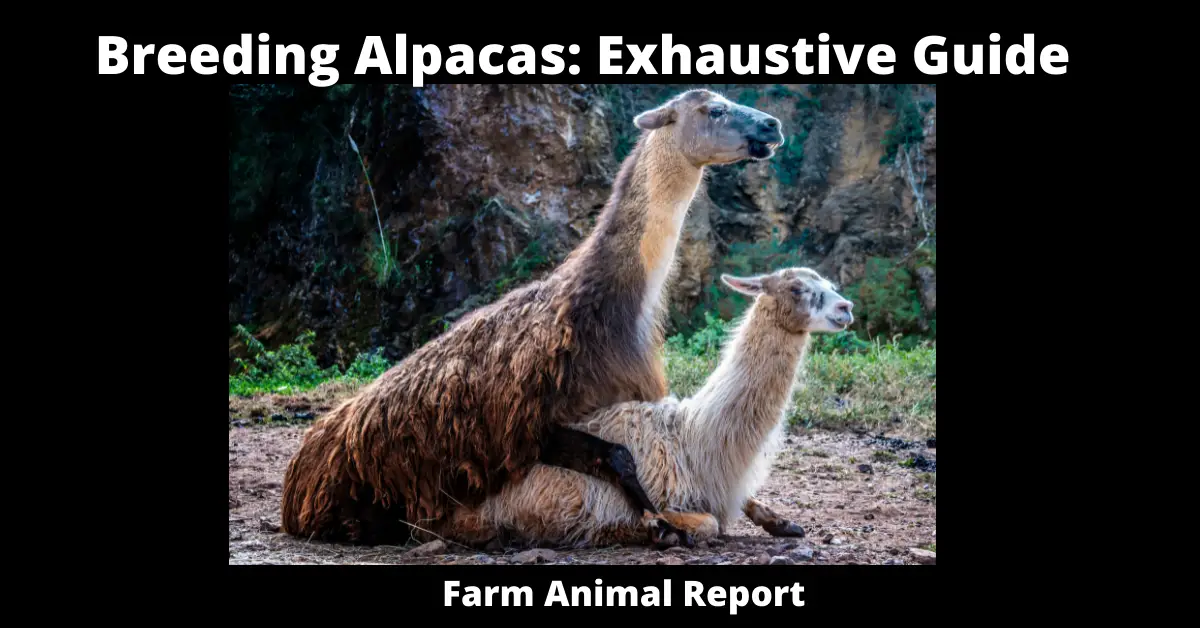As a General Rule Female alpacas begin breeding when mature or fertile until they reach 18 months to 3 years. Alpacas are female alpacas that are “induced ovulators,” which means they ovulate due to mating. The average gestation period is 11 to 12 months, but longer pregnancies are not uncommon. Births are generally uneventful, and the majority occur before noon. Cria should weigh between 12 and 20 pounds at birth, and the majority will be standing and nursing within two to three hours
Alpaca Breeding
Alpaca Breeding – Females are fully mature between the ages of 12 and 18 months or reach 90 to 100 pounds. Males exhibit interest as early as a few weeks of age but are not mature or fertile until they reach 18 months to 3 years. (Some individuals will fall outside of this age range. Alpacas do not have a breeding season, and females can be mated at any time of year if they are receptive. As with rabbits and cats, female alpacas are “induced ovulators,” which means they ovulate due to mating.
Alpacas mate in the “cush” (prone) position, and if a female is not receptive (pregnant), she will refuse to sit and will almost certainly spit at the male. This rejection response dubbed a “spit-off,” is regularly used to monitor the female’s pregnancy progress. There are several factors to consider before entering the breeding industry. It is prudent to speak with one of the leading experienced breeders first, regardless of where you intend to purchase your stock. You will learn a great deal from those who have already done the legwork.
The average gestation period is 11 to 12 months, but longer pregnancies are not uncommon. Births are generally uneventful, and the majority occur before noon. Cria should weigh between 12 and 20 pounds at birth, and the majority will be standing and nursing within two to three hours. Mothers are frequently highly protective of their offspring, and the cria will remain with the mother until weaning at 5 to 6 months of age. Females are typically remated within two to six weeks of giving birth.
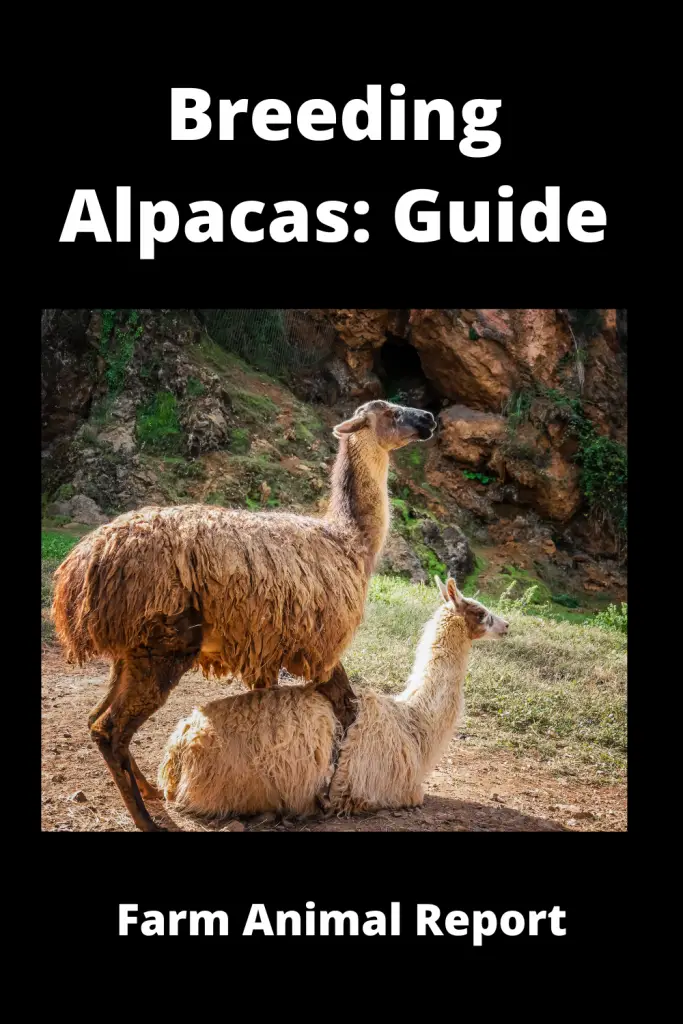
Can you Make Money Breeding Alpacas?
At the moment, approximately 85 percent of alpaca breeders earn their living solely from the sale of breeding livestock, with no regard for fleece sales. This requires ranchers to develop skills in selling and marketing their livestock.
While nothing is guaranteed, Chris Lewis believes that an investor in alpacas will achieve financial success if they make an educated effort. “The most common mistake new alpaca owners make is to spend their entire investment on breeding stock,” Lewis explains. If an investor has $60,000 to spend, he suggests allocating $40,000 to breeding stock, $10,000 to marketing and sales, and the remaining $10,000 to breeding fees, unexpected vet bills, and other miscellaneous expenses.
18 ways Alpaca Farmers make Money
Profitability also applies to what is referred to as “well-bred stock.” Due to the lack of established conformation standards, what currently wins in the show ring is whoever has the most excellent-looking animal on any given day in the ring. In other words, breeders have bred for “pretty,” emphasizing color and specific popular conformation points.
However, many in the alpaca industry are beginning to breed with an eye toward what they believe is alpacas’ only actual future: fleece production. Certain breeders are now paying closer attention to the finer technical details of fleece quality and incorporating breeding practices to enhance it.
How many Babies can an Alpaca have at a time?
Alpaca Breeding – Each year, alpacas typically produce one baby called a cria. Twins are extremely rare, occurring once every 10,000 births. They are born between 11- and 11.5-months of gestation and are remated 12 to 14 days after a normal birth. Because alpacas are induced ovulators, they can be mated at any time of year. Because artificial insemination is not available in the United Kingdom at the moment, all females and herd sires must gather for a supervised mating. Embryo transfer has been attempted in the United Kingdom but is still in its infancy.
How much does a Breeding Pair of Alpacas Cost?
Alpacas are sold at a wide variety of prices. Some alpacas are inexpensive, costing only a few hundred dollars, while one high-bred alpaca recently sold for $750,000. Alpaca prices in the United States of America range from $100 to $1 million. The price of an alpaca varies according to various factors, including its lineage, the quality of the fleece, and temperament. Additionally, the cost varies by state.
Alpacas as pets can cost as little as two or three hundred dollars or as much as $1,500 per animal. Pet alpacas typically do not reproduce well and are therefore not registered with the Alpaca Owners Association, which keeps track of alpaca lineage in the United States.
- Pet alpaca sales
- Sale of the fiber
- Costs: $200-$1,500 each
Farm-qualified alpacas are typically alpacas that are primarily used for profit on hobby farms. These alpacas produce fiber of a higher quality than their pet counterparts. Additionally, their wool may be darker in color. This higher-quality fleece is more expensive. It is typically sold to the cottage industry, which has a high demand for natural vibrant colors.
Hobby alpacas typically have a more traceable pedigree and are registered. They should give birth to healthy infants and produce healthy stock. There should be no congenital abnormalities or other complications.
How much do alpacas of farm quality cost? On hobby farms, alpacas of farm quality are used to generate profit and revenue. These alpacas typically cost around $1,500 each and can reach $5,000 depending on the alpaca’s age, quality, breeding, and physical appearance.
- Offspring of hobby-farm alpacas sell for more
- Fiber is of higher quality and sells for more
- May include darker wool colors
- Costs: $1,500-$5,000
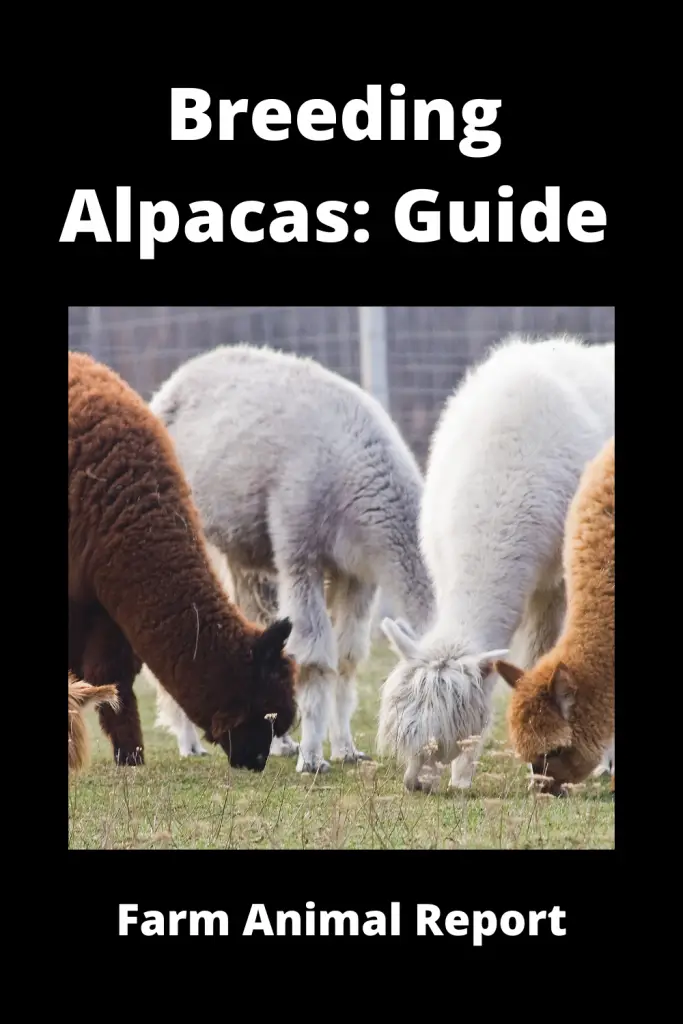
How to Breed Alpacas
Unlike many other animals, alpacas do not have a specific breeding season. Rather than that, as long as the female alpacas are receptive, they can be bred at any time of year. This is because they are introduced ovulators. This means that when they mate, they initiate ovulation.
Another peculiar aspect of alpaca breeding is their tendency for mating in a prone (cush) position. You can tell if a female is receptive or not because she will not assume this position if she is not. Additionally, she may spit in the direction of the male. This is referred to as “spit off.”
If your female alpaca appears unresponsive, you can reintroduce her to the male every couple of weeks until she becomes receptive. When the moment is right, she will refrain from spitting and readily assume the cush position. In response, the male makes a distinctive sound known as “orgling,” signaling the start of mating.
If you want to breed alpacas, there are several factors to consider first. Begin by ascertaining that you understand what you’re getting yourself into. Meet some established breeders and tour their farms to get a sense of what goes into alpaca breeding.
Compare the stock of various alpaca breeders as you visit them. This is an excellent time to decide where to purchase your first alpacas. pleasant, smart, charming individuals
Draw Up A Firm Business Plan
Make sure that you are completely prepared before purchasing any animals. You’ll need to create a business plan that accounts for all possible outcomes. Additionally, you’ll want to ensure that you have adequate housing and enclosures for your new animals, as well as a reliable feed supplier.
Learn About Alpaca Behavior and Care
Do not enter alpaca breeding without prior alpaca experience. Surprisingly, you may wish to begin with a trio of male alpacas that have been castrated (wethers). While these animals have no value as breeders, they can be precious in teaching you all about alpaca care.
Generally, wethers are inexpensive and easy to handle. You can learn the ropes by providing care for these pleasant, intelligent, and endearing individuals. When you’re ready to purchase breeding stock, you can keep your pets or rehome them.
Alpaca Breeding Requires Time And Patience
It takes time for your stock to mature to the point of breeding. Between the ages of one and eighteen months, female alpacas are mature and ready to breed. They typically weigh around 95 pounds at this stage of life.
Before breeding your female alpaca for the first time, consult your veterinarian to ensure she is healthy, strong, and has reached a mature weight that allows her to be safely bred.
How to tell if Female Alpaca is pregnant
Alpacas are induced ovulators, which means they can breed at any time of year, unlike most other mammals. This increases the likelihood that alpacas will become pregnant during one of the first breeding.
There are various reasons why alpacas do not conceive or miscarry during the early days of pregnancy. Corrective action is possible in these circumstances, but first, you must establish that re-absorption occurred.
The Spit Test
We discovered that the “spit test” is one of the simplest and quickest ways to determine whether a female alpaca is pregnant. Especially for experienced dam alpacas, they usually detect pregnancy within four days of breeding. A maiden (first-time mother) is more difficult to discern because they have never had this experience and may lie down even if pregnant. The Spit Test is simple to administer as long as you have a willing male alpaca. We do not recommend testing your breeding males too frequently, as repeated rejection will diminish their desire to breed.
Once the male begins humming, she becomes pregnant if she jumps around, spits, and kicks. If she remains still, starts sucking her lips, and lies down, she is not pregnant and is therefore ready to breed again. Once a female alpaca becomes pregnant, she refuses the male for the duration of the 11 12 months of pregnancy. She flees from the male, ears back, and prepares to spit at him to drive him away – thus the name “spit-off.”
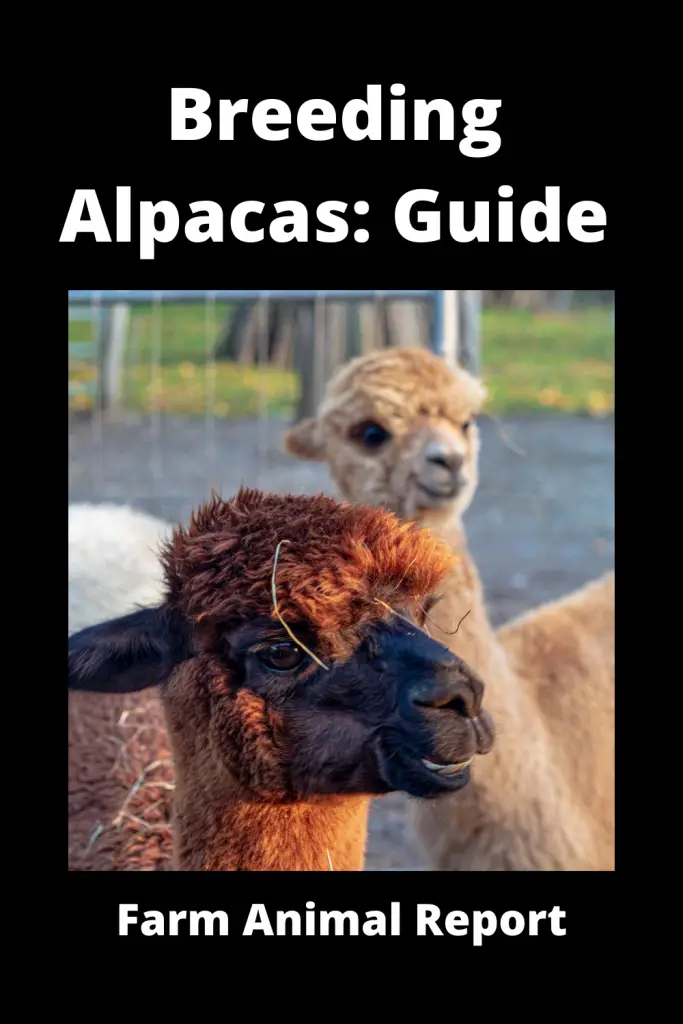
Ultrasound pregnancy test
The results of an ultrasound scan pregnancy test are highly dependent on the operator’s skill and experience and the quality of the machine used. The best, on the other hand, can detect pregnancies and fetal development 20 days after mating. A pregnant scan reveals a dark area, the fluid-filled uterus, and a brighter place within it, the cria.
You can perform scans yourself if you invest in the necessary machinery, or your veterinarian can do them for you. In some areas, mobile sheep scanners can also perform scans on your alpacas. Rectal scans are effective at detecting pregnancy in its earliest stages. Rectal examinations are also used to determine the health of the uterus and ovaries.
From day 40 of pregnancy, exterior abdominal scans are effective. We typically perform an external scan on females at 90 days of pregnancy because if we detect pregnancy at that point, it is more likely to be retained to term.
Blood pregnancy test
Progesterone levels can be determined via blood tests, which indicate pregnancy. These tests cost around $5. It is critical that the labs/vet inform you of your actual progesterone level (a number) rather than simply “pregnant/not pregnant.”
How Old Can You Breed Alpacas?
Breeders frequently want to maximize their financial return on a breeding female alpaca and thus begin breeding them at an early age. Historically, alpacas reach breeding maturity between twelve and twenty-four months, ( months of age)with some reaching thirty. While some alpacas have conceived successfully as young as five months, this is not a safe practice for either the female or the baby.
- Breeding female alpacas too early can result in complications that endanger both the female and baby alpacas’ lives.
- Before allowing your female alpaca to breed, ensure she weighs at least 88 pounds.
How Old can Male Alpacas Breed?
Males are typically ready to mate for the first time between the ages of one and three. Between 12–24 months, a female alpaca can reach full maturity (physically and mentally). Allowing a young female to breed until she reaches maturity is not recommended, as over breeding a young female before conception is possible is a common cause of uterine infections. Due to the wide variation in maturation rates between individuals, it is generally recommended that novice breeders wait until females reach 18 months or older before breeding. Alpaca Owners Association
Do Alpacas Mate for Life?
Females can breed throughout their lives with proper nutrition and a few years of rest every few years. Alpacas, as herbivores, consume only vegetation. They eat grass primarily but may also consume leaves, wood, bark, and stems. Alpacas, like other ruminants, have a three-chambered stomach that efficiently digests roughage.
In comparison to other grazers, alpacas consume relatively little food. According to the Alpaca Owners Association, a 125-pound (57-kg) alpaca consumes approximately 2 pounds (907 grams) of food per day. Alpacas consume 1.5 percent of their body weight daily on average.
Can I Keep Male and female Alpacas Together?
This is determined by the purpose for which you intend to keep your alpacas. If you want to start a breeding herd, you can start with a few females in cria (already pregnant) to avoid immediately purchasing and house studs.
If you’re looking for a friendly herd to keep as pets, you’re best off with young or gelded (castrated) males. They have a more gentle temperament than females (most of the time!) and are significantly less expensive than females.
It would help if you did not keep multiple entire male alpacas in the same enclosure as females or proximity to females. Male alpacas have a propensity for fighting to compete for mates. They have fighting teeth in the back of their mouths, which they use to castrate potential adversaries. Although the teeth are trimmed annually during shearing time, they can still be inflicting severe injury during combat.
It is also critical not to house a stud alone due to socialization issues (see the previous paragraph). While keeping a single male near females may be acceptable for a short period (for example, to paddock mate), this should not be a year-round solution, as males can harass and seriously injure females, sometimes resulting in miscarriage.
While it is true that male and female alpacas can coexist happily in Peru’s wild terrains, it is essential to remember that they have significantly more space to roam. The higher female-to-male ratio ensures that females are not harassed. Therefore, if you lack the space to separate males from females but still require breeding solutions, we recommend outsourcing stud services.
How many Alpacas should you have?
Alpacas, being herd animals, should always be kept in groups of at least three. They thrive on social interaction and can develop stress and illness if left alone. Your herd’s prime size will also be determined by the amount of land available to you. Stock density is recommended at 5-6 alpacas per acre. If you can split the pasture or acquire another to allow for rotational grazing, you can ensure that you have enough high-quality grass all year while reducing the risk of worms.
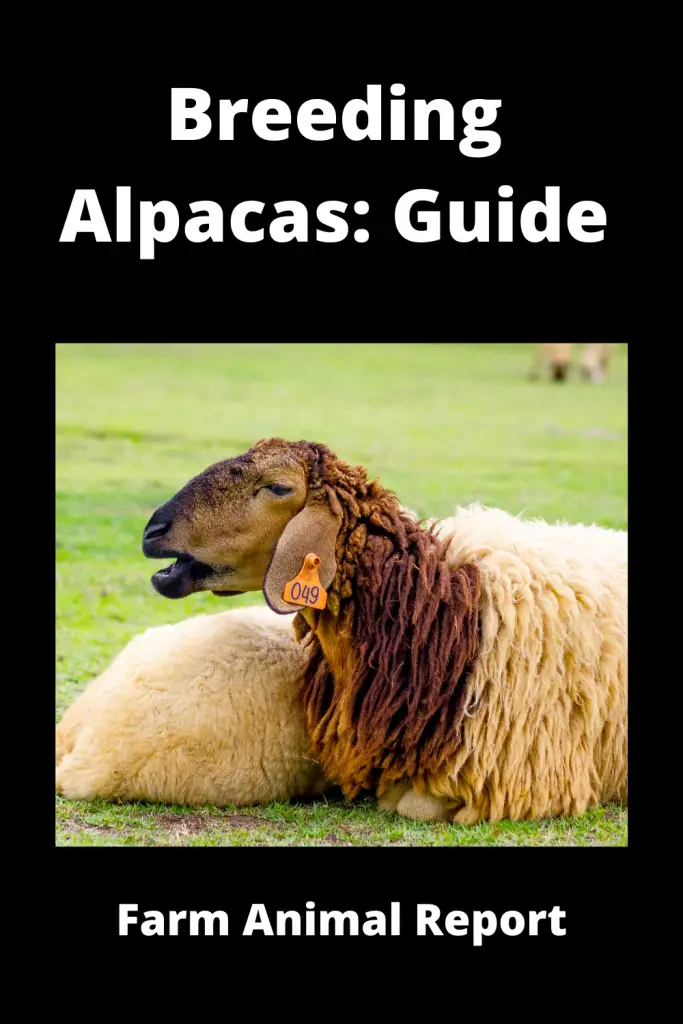
Can Male Alpaca Breed a Female Llama?
Male Alpacas breeding with female Llama produce a more desirable Huarizo. However, breeding female alpacas with male llamas can result in large offspring, resulting in congenital disabilities, stillbirth, and other complications during labor and delivery.
Guanaco and Vicuna are the wild ancestors of alpaca (assumed and partially proven), but all of them can breed with one another; Llama, Vicuna, Guanaco, and Alpaca all produce fertile young. Huarizo, the Llama/Alpaca mating offspring, generally has more pleasant dispositions and more extended, more delicate, softer hair.
How do Alpacas Differ from Llamas?
Alpacas, llamas, guanacos, and vicunas are all camelid (or camel) families found in South America. Alpacas are smaller than llamas and have a more sophisticated fleece than llamas. Alpacas have historically been bred for their fleece, whereas llamas have traditionally been bred for their pack and trekking abilities. Alpacas typically weigh between 60 and 80 kilograms, whereas llamas weigh between 150 and 210 kilograms.
Learn More – 18 Ways to Make Money Alpaca Farming
Final Thoughts
Because alpacas are induced ovulators, they can be mated at any time of year. Because artificial insemination is not available in the United States at the moment, all females and herd sires must come together for supervised mating. Embryo transfer has been attempted in the United States but is still in its infancy.
| Farm Name (Open Herd) Over 1200 Alpaca Farms in United States | Herd Size | Location | Contact | Price - Open Females | Males | Stud Fee |
|---|---|---|---|---|---|---|
| Flatland Farm | 18 | Kansas | Dian and Steve Trainer 21302 SW County Line Rd Rose Hill, KS 67133 316-469-9816 316-250-2231 | Open Female $2,000 - $ 6,000 | $2,000 - $12,000 | $1000 |
| Lizard Hill Suri Alpacas | 25 | Colorado | Kent and Sandy Murray 351 PURDY MESA RD Whitewater , CO 81527 970-250-7335 970-243-3520 | $ 500 - $650 | $500 - $1,200 | |
| Alpacas of Paca Meadow | 26 | Washington | Berne and Linda Thorpe 354 Bickleton Highway GOLDENDALE, WA, WA 98620 2535089757 | Call for Pricing | Call for Pricing | Call for Pricing |
| Oden Falls Alpacas | 67 | Oregon | Odin Falls Alpacas Allen Kallel 9101 NW 31st St. Terrebonne, OR 97760 Call Us 5414102324 | Call for Pricing | Call for Pricing | Call for Pricing |
| Circus City Alpacas | 23 | Indiana | Richard/Andrea Hammersley 2642 W 200 N Peru, IN 46970 765-863-3701 765-863-3702 | $ 4,000 - $5,000 | $1,000 - $5,000 | $750 |
| Alpaca Bella Fina Ranch LLC | 39 | North Carolina | Della, Shelby, Mercedes Wagnon 00000 Rocky Mount, NC 27801 1-208-315-5843 | Call for Pricing | Call for Pricing | Call for Pricing |
| Zodiac Ranch | 53 | Michigan | Linda Lundstrom 2791 North Wixom Rd. Milford , MI 48381 (248) 685-0403 248-202-0178 | $1,500 - $12,000 | $3,000 - $25,000 | $500 - $1,000 |
| Redhaven Ranch | 20 | Utah | Red & Marie Armfield 4008 W 1800 N West Point, UT 84015 801.791.7579 801.549.7779 | $ 500 - $2,500 | $ 1,000 - $3,000 | $1,000 |
| Exotica Farm Alpacas | 15 | New York | James Ward 4636 State Route 13 Truxton , NY 13158 315-289-5078 | Call for Pricing | Call for Pricing | $500 |


